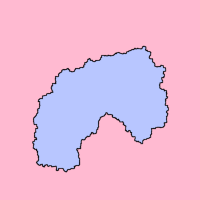
Back مبرهنة منحنى جوردان Arabic Teorema de la corba de Jordan Catalan Jordanscher Kurvensatz German Teorema de la curva de Jordan Spanish قضیه منحنی ژوردان Persian Jordanin käyrälause Finnish Théorème de Jordan French משפט העקום של ז'ורדן HE Jordan-féle görbetétel Hungarian Ժորդանյան կոր Armenian

In topology, the Jordan curve theorem, formulated by Camille Jordan in 1887, asserts that every Jordan curve (a plane simple closed curve) divides the plane into an "interior" region bounded by the curve and an "exterior" region containing all of the nearby and far away exterior points. Every continuous path connecting a point of one region to a point of the other intersects with the curve somewhere. While the theorem seems intuitively obvious, it takes some ingenuity to prove it by elementary means. "Although the JCT is one of the best known topological theorems, there are many, even among professional mathematicians, who have never read a proof of it." (Tverberg (1980, Introduction)). More transparent proofs rely on the mathematical machinery of algebraic topology, and these lead to generalizations to higher-dimensional spaces.
The Jordan curve theorem is named after the mathematician Camille Jordan (1838–1922), who published its first claimed proof in 1887.[1][2] For decades, mathematicians generally thought that this proof was flawed and that the first rigorous proof was carried out by Oswald Veblen. However, this notion has been overturned by Thomas C. Hales and others.[3]
- ^ Jordan (1887).
- ^ Kline, J. R. (1942). "What is the Jordan curve theorem?". American Mathematical Monthly. 49: 281–286. doi:10.2307/2303093. MR 0006516.
- ^ Hales, Thomas C. (2007). "Jordan's proof of the Jordan curve theorem" (PDF). From Insight to Proof: Festschrift in Honour of Andrzej Trybulec. Studies in Logic, Grammar and Rhetoric. 10 (23). University of Białystok.
© MMXXIII Rich X Search. We shall prevail. All rights reserved. Rich X Search